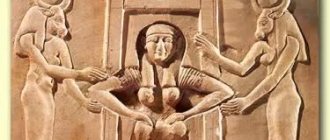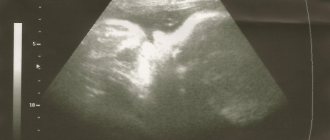What are pushing
The duration of labor varies from 2 to 14 hours, depending on the age of the patient and the history of childbirth (usually in primiparous women, labor lasts 10-12 hours, in contrast to multiparous women - no more than 3 hours).
Labor process:
- the first cramping pain, an interval of 30 minutes;
- increased frequency of contractions - the interval is 5 minutes;
- contractions merge - a constant contraction flowing into attempts;
- development of labor;
- birth of a child;
- postpartum stage.
Pushing is a contraction of the abdominal and uterine muscles, including the diaphragmatic reflex to push the baby out of the womb. In other words, this is the process of pushing the child out.
There is no pain when pushing: the cervix is sufficiently dilated and softened. Unlike contractions, pushing lasts only a short time.
To properly push the baby out, a woman needs to listen to the midwife and push correctly.
The difference between contractions and pushing
Contractions are muscle tension and contractions of the uterus. It is impossible for a woman to control the contractive process. To make it easier, nurses inject a drug that relaxes the smooth muscles of the uterus.
In the second stage of contractions, pushing occurs - this is a process controlled by the woman in labor. She is able to stop pushing the baby out for a very short period in order to catch her breath and again help the baby to be born.
When do they start
By pushing we mean the second phase of labor, immediately before the baby is born. In the first period, the cervix opens, opening the way for the baby, after which the process of childbirth begins, designed to help the newborn leave the womb. They come after the period of contractions becomes very short and strong.
Sometimes this period is also called the expulsion period, since it helps to expel the baby from his refuge, although most mothers do not like this name, because they have been waiting for the appearance of their baby for many months.
Did you know? Only one in twenty women gives birth on the day chosen by doctors. Babies are usually born between one and two weeks after their due date. But firstborns are most often born 4 days after day X has struck.
So, let's try to figure out what it is, pushing during childbirth, and how it happens. Pushing is a contraction of all the abdominal muscles and the diaphragm, the septum that separates the thoracic and abdominal parts of the body. Thanks to it, internal pressure increases, which allows the baby to move forward. It occurs because the fetus irritates the nerve receptors of the uterus, vagina, and pelvic muscles. That is why they appear involuntarily, but the woman in labor can control them.
When they appear during childbirth
Pushing is a condition comparable to defecation, so before transferring the pregnant woman to the maternity ward, a cleansing enema is given.
The appearance of labor pains is individual for each pregnant woman. On average, the pushing period lasts no more than 2 hours; for multiparous women it is about 30 minutes.
If a woman in labor knows how to breathe correctly, listens to the doctor and pushes correctly, the baby will be born faster. Contractions precede pushing. They are the ones who take away the pregnant woman’s strength, but to give birth to a child, a little more patience is needed.
The main thing when pushing is to know that the woman’s health depends on the child’s health. So, for example, if a woman holds back while pushing for fear of spontaneously emptying her bowels, then the baby cannot breathe due to the lack of water and oxygen.
At this moment, she may swallow the remaining mucus, amniotic fluid or maternal blood, which will lead to irreversible consequences.
The number of attempts to give birth to a baby is set by nature individually for each pregnant woman, so it is difficult to answer the question “How many attempts can it take to give birth?”
According to statistics, on average, firstborns push the baby out in 8-10 attempts.
First birth: delivery of the placenta
After the birth of a child, the body receives a short break, so contractions return, although not as strong as before. The body now gets rid of the placenta. In cases where this does not happen, the “baby spot” is removed by a doctor. The woman in labor remains in the delivery room for another 2 hours, during which time the obstetrician must make sure that the woman is not bleeding. Having safely given birth, begin the duties of a mother - feed the baby and take care of his health.
The first birth does not always go smoothly; sometimes it is accompanied by complications, which we will discuss later.
Feelings of a woman in labor during pushing
The pushing period is characterized by the presence of minor pain. A state of feeling like you really want to go to the toilet.
During labor, contractions are painful, as the cervix opens, stretches, and the uterus contracts. During childbirth, contractions turn into pushing.
Pain may be due to perineal ruptures, if the child is large or the woman behaves incorrectly.
The occurrence of pain syndrome depends on the mother’s pain threshold; the higher it is, the more painful the sensation.
Complications during the first birth
Due to objective reasons, the first birth may occur with complications. Here are some of them:
- ruptures. A large fetus, rapid labor when the cervix does not have time to open normally, and unprofessional obstetricians can lead to ruptures and bleeding. To avoid this, first consult with your gynecologist about whether the size of the fetus matches your birth canal and take care in advance of choosing the doctor who will deliver your baby;
- weak labor activity. There is nothing wrong with this if it is detected in time and contractions are stimulated;
- bleeding. Its appearance depends on many factors: the attachment of the placenta, the degree of blood clotting, the presence of injuries received during pregnancy, hormonal imbalance, etc. Do all the tests and examinations that the doctor who is monitoring your pregnancy prescribes for you, then doctors will have a complete picture of your condition and they will be able to foresee possible risks of blood loss.
All other complications are characteristic, as a rule, of multiparous women, and therefore you should not be afraid of them during the first birth.
For more information about the first stage of labor, watch the video:
Breathing is the key to successful childbirth
Breathing plays one of the main roles at the time of childbirth. The right tactics allow the woman in labor to remain calm, speed up the process of the birth of the child and help to accumulate all her strength.
- Breathing between attempts should be shallow, not deep. It resembles the breathing of a dog;
- Inhale through the nose, exhale through the mouth. You should push while exhaling.
It is also important to remain calm during contractions. When the time between contractions decreases, you need to breathe through your nose while in an upright position.
At the moment of a fight, it is difficult to control emotions, but screaming will only worsen the situation: the capillaries in the eyes will burst, and a headache will appear.
How to push correctly
The first thing you need to do is listen to your midwife and medical staff.
For the easiest birth, you must follow the following rules:
- A cleansing enema allows you to alleviate the condition of a pregnant woman and avoid having a bowel movement at an inconvenient moment. An enema is a prerequisite for transfer to the maternity ward.
- Childbirth takes place in an obstetric (gynecological) chair. For convenience, a special loop is hung above the chair, allowing the woman in labor to lie down comfortably.
- Before starting to push, you should inhale through your nose, tuck your knees, rest your feet, or hold your legs with your hands.
- As you exhale, as you begin to push, begin to push down. The emphasis should be placed not on the stomach, but on the vagina, trying to “blow” the baby out of it.
- You need to push until the air runs out. The child tries no less than the mother, and with double strength the birth will be successful.
- As soon as the push is released, you have a few seconds to gain strength and inhale again.
After the birth of the baby, labor does not end - the woman “gives birth” to the baby’s place – the placenta. To do this, you should inhale again and push it out.
Attempts stop from the moment the placenta is removed. The birth is completed.
How to behave. Tips for relieving a woman's condition
The process of childbirth is perhaps the most difficult test in a woman’s life. But no matter how difficult it is, there are several tips that will help the expectant mother alleviate this condition, cope with nerves and calm down.
- Listen to the doctor. He will be the first to determine whether everything is fine or if he should wait. Follow his instructions, and then the baby will be born on time and without complications.
- Use correct breathing technique. It will allow you to relax when necessary, or gather all your strength while trying to give birth.
- To stop the impulse, you need to relax your whole body as much as possible. Inhalations should be short and frequent, the so-called dog breathing.
Important! The first thing a woman should learn to do during pregnancy is relax. Completely, keeping calm throughout the body, and always confidently. This will not only help with the birthing process, but will also allow the body to control the pushing process.
- Correct pushing also depends on when mommy pushes. The best time for this will be the peak of the impulse, allowing you to direct the most energy to the process.
- It is imperative to maintain even and smooth breathing. If you exhale sharply, the baby may be pulled back into the vagina.
- Yelling is a bad option. This only wastes the body's strength. It’s better to remain silent or groan, but maintain all your strength and concentration.
- As you inhale before pushing, imagine a ball that you are swallowing. Feel it inside you and direct it from your stomach to the point of pain. This will allow you to maintain concentration and focus your strength.
The effect of pushing on a child
With each new attempt, the child penetrates more and more into the environment. That is, with each pushing movement, the baby gradually overcomes the birth canal to meet the mother.
During the period of pushing, it is important to listen to the doctor so as not to harm the child.
- Advancing the baby's head
The fetal head penetrates through the genital slit during the first push, and when it disappears, the head also hides. Pushing during this period is very important, because the child is in a state of temporary hypoxia.
- Birth of the baby's head
The vulvar ring becomes wider with each pushing exercise, and the emerging forehead prevents the gap from closing. The entire head (forehead, nose, face, chin) is born. In 1-2 attempts, the baby's head is born.
- Birth of the torso and legs
When the baby is presented correctly, labor proceeds fairly quickly. After the head appears, the body is born. Doctors and midwives help the baby. The shoulders are born in turn: first one, then the other. When they are born, it is important not to overdo it from the outside, as you can damage the brachial plexuses and cervical vertebrae. After the birth of the fetus's arms, they are placed on the chest and the baby is brought out completely. The child is born.
The child’s condition is assessed using a 10-point Apgar scale, which takes into account: muscle tone, heart rate, presence of reflexes, skin color and depth of breathing.
The period of pushing has its effect on the born baby. Long and difficult labor rates the baby’s condition at 6-8 points.
If labor is weak, the baby is removed from the mother with special obstetric forceps. If you do not use forceps, there is a high probability of the baby being born still, or with low scores on the rating scale.
What is the difference between pushing and contractions?
Often women confuse these two concepts. Despite the fact that these phenomena have a common goal - the expulsion of the fetus from the mother's womb, and are considered integral components of the process of natural childbirth, they have significant differences. Comparative characteristics of contractions and pushing during labor are shown in the table.
| Delivery stage | Definition | Features of the course | Average duration, hours | Ability to control the process | |
| In primiparas | In multiparous women | ||||
| Contractions | Uncontrolled regular contractions of the uterine muscles | Contractions take place in 2 stages:
| 12 | 8–10 | Absent |
| Attempts | Reflex contractions of the abdominal muscles and diaphragm | A woman in labor has a desire to push every 10–15 seconds, resulting in an increase in intra-abdominal pressure. | 2 | 1 | Despite the fact that pushing occurs reflexively, the woman in labor has the ability to control them. |
The end of pushing and the postpartum period
As soon as the baby took his first breath. It is placed on the mother's stomach to create mother-baby contact, then applied to the breast to produce progesterone and prolactin.
These hormones promote the rejection of the placenta.
The child is processed and taken to the children's department. The mother is in the postpartum room under the close supervision of doctors for at least an hour and a half.
All this time, the uterus is cold, and substances that prevent the development of bleeding enter the vein. The uterus contracts, and accumulated blood clots come out of its cavity.
Attempts in first-time mothers: how to facilitate the birth process
When a woman has not given birth for the first time, she already knows how best to behave and what to do during pushing. But if this is your first pregnancy, then these few tips will be very useful:
- There should be three attempts per contraction. The optimal time for one push is 5-7 seconds. Therefore, it is a big mistake to do one long push; it is more effective to do several short ones.
- If you don't know how to tell when pushing is starting, ask your doctor to remind you when to push.
- You don’t need to give it your all, otherwise you won’t have enough strength by the end of labor. Therefore, try to distribute the forces evenly.
- Never inhale or exhale sharply, this will have the opposite effect and the child will be pulled back.
- Do not waste your energy screaming; if the pain during pushing is very strong, it is better to groan. In addition, screaming provokes the release of adrenaline, which causes an outflow of oxygen and, as a result, fetal hypoxia.
- Don’t give in to panic attacks, pull yourself together and endure these couple of hours with dignity, because there’s still quite a bit left and you’ll meet your baby.
Recommendations for women in labor
- After transfer to the obstetric department, try to fall asleep lying on your stomach, but be sure to go to the toilet before that;
- At the time of birth, do not clamp down and listen carefully to the midwife;
- Try to avoid pain relief during labor;
- Don’t rush to pick up your child from the children’s ward - you should gain strength;
- Eat porridge or soup without bread;
- If an episiotomy was performed during childbirth, it is necessary to visit a physiotherapist and go to the sutures.
In the postpartum period, monitor the process of urination and defecation.
Lack of stool and urine negatively affects the health of the mother.
Limit physical exercise.
Author: Elena Yuryevna, obstetrician-gynecologist of the highest category Specially for the site kakrodit.ru
How can you tell when contractions have started?
You should pay attention to contractions if:
- The attack of pain lasts 30 seconds or more.
- Painful sensations intensify more and more, and the frequency also increases.
- Some women experience a plug of mucus mixed with blood before contractions.
- Minor bleeding appeared.
- Sometimes the water breaks.
Over time, the pain spreads from the lower abdomen to the lower back and intensifies.
Contractions accompany labor from beginning to end. Even after the baby is delivered, they will still be there to reject the placenta. By the way, when the uterus begins to contract after childbirth, the pain is similar, though not as strong, but still noticeable. Attempts occur only once for a specific purpose and disappear after the birth of the baby. Pregnancy is a wonderful time, and in most cases ends with childbirth. Natural childbirth is a labor activity conceived by nature itself. As the baby passes through the birth canal, it gains strength.
Contractions without pain
This also happens, especially at the very beginning of labor. The sensations, however, are quite unpleasant. Expectant mothers usually feel how the uterus becomes toned for a few seconds - the stomach “turns to stone”, then relaxes again. Similar sensations arise if you do it during contractions.
Ksyusha_SD:
I kept walking and thinking, how will I understand that this has begun? I felt good and there were no changes in my appetite either. I really understood only when the contractions started - the tone of the tummy just began periodically.
Of course, not everyone is so lucky, but it happens that a woman is not very susceptible to pain. So at the beginning of labor, while the pressure on the cervix is low (or, for example, it has a flat membrane in which), the sensations may be unpleasant, but not painful.
Types of pushing behavior
A woman can choose the type of behavior during childbirth herself in a preliminary consultation with her doctor. It’s worth doing this in advance so that you have time to prepare and practice proper breathing. There are two types of behavior when pushing:
- natural;
- controlled.
With the natural type, a woman trusts her own body and does not control her attempts. The doctor monitors the process and helps you adapt to the situation. The main task of a woman in labor is to relax and help her body do everything as required, without holding back labor efforts.
This type of behavior is suitable for those who have given birth for more than the first time and tolerate pregnancy well. In this case, the fetus must be correctly positioned, that is, turned head down.
The controlled type of behavior is more suitable for those who are giving birth for the first time and are very afraid of doing something wrong. In this case, it is better to completely trust the doctor and follow his recommendations. During pushing, the woman in labor is given a signal when to push. In this way, the obstetrician can synchronize the woman’s actions with the progress of the fetus.








